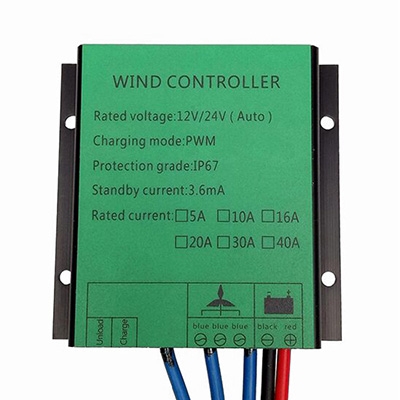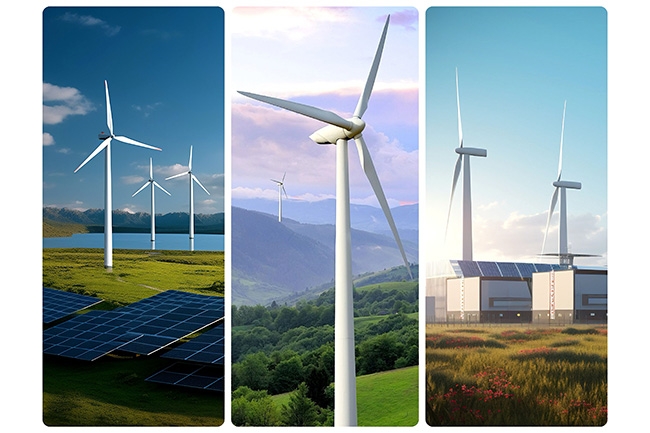Developing renewable energy sources is becoming increasingly important in the context of growing energy demands. Wind energy, as a clean and renewable resource, has been widely utilized globally. Wind turbines, as the primary equipment for wind power generation, directly impact the efficiency and stability of the entire system. The wind turbine charge controller is among the crucial components of wind power systems, whose role cannot be overlooked. Home Power Inverter delves into the functions, principles, and significance of wind turbine charge controllers in wind power systems.
What is a Wind Turbine Charge Controller?
Wind turbine charge controllers, also known as wind power controllers or wind energy charge controllers, are intelligent devices designed specifically for wind power generation systems. These controllers are responsible for efficiently converting the energy generated by wind turbines and charging the batteries while offering robust control functions to ensure the stable operation of the system. By precisely adjusting the output power of wind turbines, optimizing energy distribution, and protecting the system from adverse conditions, wind turbine charge controllers play a vital role.
What Does a Wind Turbine Charge Controller Do?
1. Battery Charging Management: The primary function of a wind turbine charge controller is to manage battery charging. It monitors the voltage and charging current of the batteries, ensuring they are charged safely and efficiently. When the battery voltage approaches the set value, the controller automatically reduces the output power of the wind turbine to prevent overcharging. Conversely, when the battery voltage is below the set value, the controller increases the turbine’s output power to ensure the battery is fully charged. This functionality not only extends battery life but also enhances overall system efficiency.
2. Load Control: Load control is another critical function in wind power systems. When the battery voltage is below the set value, the battery supplies power to the load. The wind turbine charge controller then allocates the turbine’s output power according to the load’s current demand. By precisely controlling this distribution, the controller prevents excessive load current from causing low battery voltage, thereby maintaining system stability and reliability. This function is particularly important in practical applications where load variations are significant.

3. Protection Measures: Wind power systems operate in complex environments where factors like wind speed changes and extreme weather can adversely affect the system. Therefore, wind turbine charge controllers need to have various protection measures such as overcurrent, overvoltage, undervoltage, and short-circuit protection. These measures ensure that the power supply is immediately cut off or the output power is adjusted when abnormalities are detected, protecting the equipment and preventing system failure. For example, if wind speeds are too high, the controller will limit the turbine’s output to prevent damage from overspeed; if the battery voltage is too low, it will disconnect the load to avoid excessive discharge.
4. Energy Optimization: Wind turbine charge controllers also feature energy optimization functions. In wind power systems, the generated power may exceed the demand of the load and battery. In such cases, the controller intelligently distributes the excess energy to maximize overall system efficiency. For instance, if the batteries are fully charged and the load demand is low, the controller can dissipate the surplus energy through a dump load, preventing waste.
Technical Principles of Wind Turbine Charge Controllers
Wind turbine charge controllers typically employ advanced control technologies and algorithms to achieve precise power adjustment and efficient energy distribution. One common control method is PWM (Pulse Width Modulation). By adjusting the duty cycle of the PWM signal, the controller can achieve step-less regulation of the wind turbine’s output power. This method offers high precision, fast response, and low energy consumption, making it widely used in modern wind power systems.
Moreover, these controllers use microcontrollers, such as single-chip microcomputers, as core control components. These microcontrollers have strong data processing and logical judgment capabilities, allowing real-time monitoring of parameters like battery voltage and current, and enabling quick responses based on preset control strategies. Additionally, microcontrollers feature extensive interfaces and communication functions, facilitating data exchange and remote control with other devices or systems.
The Role of Wind Turbine Charge Controllers in Wind Power Systems
In wind power systems, the role of the wind turbine charge controller is crucial. It not only ensures the stable operation of the system but also serves as a vital means to enhance efficiency and reliability. Specifically, wind turbine charge controllers play significant roles in the following areas:
- Improving System Efficiency: By precisely adjusting the output power of the wind turbines and optimizing energy distribution, wind turbine charge controllers can significantly enhance the overall efficiency of the system. When wind resources are abundant, the controller ensures that the wind turbine operates at maximum power output; when wind resources are insufficient or load demand is low, the controller adjusts the output power and dissipates excess energy to prevent waste.
- Ensuring System Safety: Wind turbine charge controllers come with comprehensive protection measures that can promptly cut off the power supply or adjust the output power when the system encounters anomalies, ensuring system safety. These protective measures include overcurrent, overvoltage, undervoltage, and short-circuit protection, effectively preventing equipment damage or system failures.
- Extending Equipment Lifespan: By precisely controlling the battery charging process and the current demands of the load, wind turbine charge controllers can extend the lifespan of batteries and loads. For example, during the charging process, the controller monitors the battery's voltage and current. The 500W wind turbine mppt charge controller available on Inverter.com can protect the wind turbine and prevent battery overcharging and under-voltage. When the load varies, the controller appropriately distributes the wind turbine's output power, preventing excessive load current from impacting the system. These measures help reduce the wear and failure rates of the equipment, thereby extending the lifespan of the entire wind power generation system.
- Enhancing System Adaptability: Wind power systems face complex and variable environmental conditions, including fluctuations in wind speed, temperature changes, and grid connection requirements. Wind turbine charge controllers use intelligent control strategies to flexibly respond to these changes, enhancing system adaptability. For example, when wind speed changes rapidly, the controller can quickly adjust the wind turbine's output power to maintain system stability; during grid faults or power outages, the controller can switch to standalone mode to ensure the power supply to critical loads.
- Boosting System Intelligence: With the continuous development of IoT, big data, and AI technologies, wind power systems are progressively moving towards intelligence. As a vital component, wind turbine charge controllers also incorporate these advanced technologies. By integrating sensors, wireless communication modules, and intelligent algorithms, the controller can monitor system operation in real-time, collect and analyze large amounts of data, and support optimized system operation. Furthermore, the controller can communicate with remote monitoring centers, enabling remote monitoring, fault diagnosis, and automatic maintenance, thereby enhancing system intelligence and operational efficiency.
- Promoting Renewable Energy Adoption: The application of wind turbine charge controllers in wind power systems not only improves system efficiency, reliability, and intelligence but also promotes the adoption and use of renewable energy. By reducing the cost and complexity of wind power systems and improving their economic viability and practicality, controllers make wind power a more feasible and popular renewable energy solution. This contributes to the transformation of the global energy structure and the achievement of sustainable development goals.

In conclusion, wind turbine charge controllers play a vital role in wind power systems. By precisely adjusting the output power of wind turbines, optimizing energy distribution, providing protective measures, extending equipment lifespan, enhancing system adaptability, and boosting system intelligence, they ensure the stable operation and efficient power generation of wind power systems. With continuous technological advancements and expanding application scenarios, Home Power Inverter believes that wind turbine charge controllers will play an even more significant role in the future, contributing to the development and adoption of renewable energy. Therefore, when designing and constructing wind power systems, it is crucial to pay close attention to the selection and configuration of wind turbine charge controllers, ensuring they meet the actual needs of the system and future development requirements.
